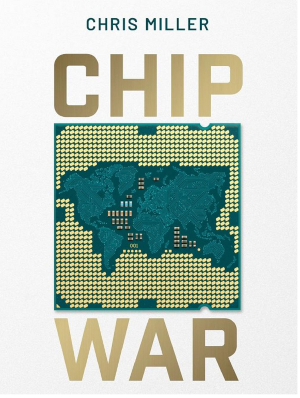
Chip War
By Chris Miller
Score: 5/5
I've finished reading Chris Miller's Chip War, the history of the semiconductor industry. This is one of the best books I've read for a long time. It is much more than just a history though.
Semiconductors are a (perhaps the) foundation of modern life and are now present in almost everything manufactured, not just computer processors (CPU's). Also chips for networking (including wifi), communications, manufacturing, medical, power. And weapon systems.
So from the physics, to the engineering, manufacturing, supply chains and logistics, we have an essential technology, globalised and now wrapped up in "Great Power" competition. The book is almost up to date and climaxes with the US/China rupture over trade and technology, with the US now awake to the Chinese threat to their continued technological domination. It is almost gripping.
The technology now used to create these devices is breathtaking. Arthur C. Clarke's said :
Any sufficiently advanced technology is indistinguishable from magic
Reading this book, particularly the chapter on the Extreme Ultraviolet (EUV) Lithography process, brought this old quote to mind on a few occasions. The world is full of "magical" technology today but we barely recognise it as such because we are so used to it.
One scientist called the development of EUV as "what felt like infinite money for solving an impossible problem". This research had been going on for decades and some people didn't think it was actually possible. The scale of the latest transistors (the building block of everything) was getting so small (tens of nanometres (nm)) that the wavelength of light needed to "etch" them was also getting so tiny that quantum effects can cause problems. Some very advanced science is needed today at the cutting edge.
For instance: just producing the light needed for the process now is very difficult. This development originated with a US company called Cymer; experts in laser light sources. From the book :
The company's engineers realised the best approach was to shoot a tiny ball of tin measuring thirty-millionths of a meter wide moving through a vacuum at speeds of around two hundred miles per hour. The tin is then struck twice with a laser, the first pulse to warm it up, the second to blast it into a plasma with a temperature around half a million degrees, many times hotter than the surface of the sun. This process of blasting tin is then repeated fifty-thousand times per second to produce EUV light in the quantities necessary to fabricate chips.
Approaching magic? Well, we're certainly getting close.

This laser had to be designed and built: it didn't exist. This in itself is a marvel of engineering. The people that built it: a German company called Trumpf. Their web site includes a picture of this (shown on the right).
The actual EUV machine itself is built by a Dutch company called ASML. The technology involved is well described on their own page. It is one of the most complex machines ever built and not only very expensive (we are talking hundreds of millions dollars) but increasingly wrapped up in the new hard rules on export imposed by the US.
Below: The ASML EUV Lithography system :
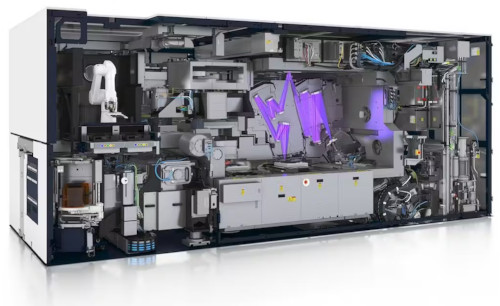
Although the likes of the Taiwan Semiconductor Manufacturing Company (TSMC) are the undisputed kings of silicon chip fabrication in 2023 (and this is unlikely to change in the near or even medium term), the USA still has a huge amount of leverage over the industry and many chip "choke" points. The dilemma is that Taiwan, like South Korea and Holland, are allies of the US, so to target China or claw back manufacturing onshore, means treading a very fine line.
The consequences of a Chinese war for Taiwan would likely be absolutely disastrous for the world due to the impact on the the silicon chip supply. Not just logic chips, but memory and NAND (flash) as well. A severe impact which will affect everyone very badly. This is a dangerous piece of history playing out right now, and as Miller says in the book, Taiwan is the "beating heart of the digital world".
Great book.
Over the years, you see and recognise the same painters and can watch them get better over time. Some artists paint in a very realistic style, which is impressive from a technical point of view and sometimes also produces a beautiful work of art. Occasionally, a "hyper real" style can seem too much like a photograph and this is probably a common criticism. My take is that the ends justify the means and if the ends look like this work by Lucy McKie then I'm very glad to see it. Colour, composition and technique come together to create something beautiful.
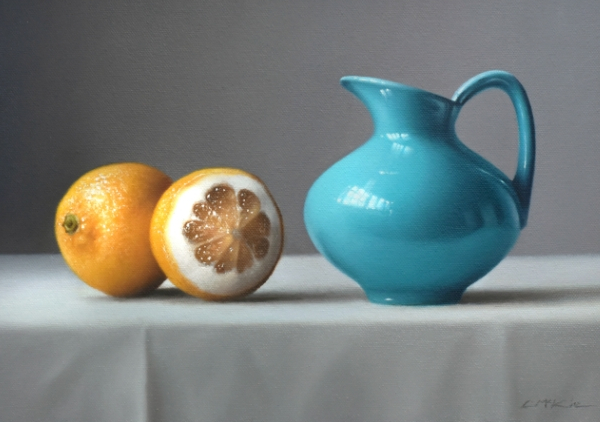
Above: Blue Jug with Two Lemons, Lucy McKie, 25 x 35 cm, Oil.
You can see this work at the Mall Galleries site. Make sure you look through the rest of the Royal Institute of Oil Painters 2023 exhibition to see much more by some great artists.

I'm reading the book Chip War by Chris Miller, about the history of the semiconductor industry. It looks at technology, logistics and at the increasingly fraught politics of the manufacture of advanced computer chips.
I know some of the history here, especially from a Silicon Valley and USA perspective, but there's plenty I'm learning (and I am only a quarter of the way through the book). A trivial example: I'd never thought of the origin or meaning of the term computer "chip". It turns out that it's from the way the integrated circuits were all created on a single piece of silicon and then each individual circuit was "chipped" off the whole to make the part.
A huge amount of very innovative work was done in the semiconductor and transistor field in the fifties and sixties and it continues to this day. The technology is, in some ways, almost indistinguishable from magic.

I went to see the new National Gallery of Scotland exhibition The Printmaker's Art | Rembrandt to Rego. Printing is both art and craft, and here you often need to make the tool to then make your art. For instance, etching a copper plate or sanding a stone block for lithographic printing. The exhibition has some good videos showing a few of the printing techniques available to an artist (the videos are also on their YouTube channel).
There are some very good prints on display here, some phenomenally good. An example of the latter is Claude Mellan's Head of Christ, an engraving printed on paper.
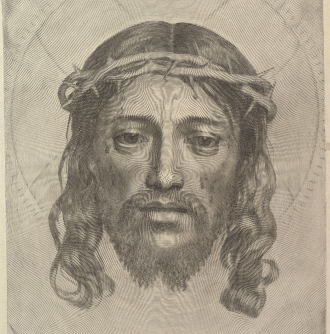
As the information in the gallery box says :
"Incredibly, this entire image has been formed using a single engraved line swirling outwards from the tip of the nose."
Right: Face of Christ on St. Veronica's Cloth, Claude Mellan, 1649. Engraving; second state of two.
NOTE: The image is taken from The Metropolitan Museum in New York. To properly see the amazing print, you need to see it in person or, at least, go to the Met link.
There is a whole other side to Rembrandt's artistic output: printmaking. He was a master of the art and the exhibition has an example of this in his print Christ Presented to the People ('Ecce Homo'). The gallery shows two versions, a later one he reworked, showing his mastery of the Drypoint printing technique. The print is made by using a needle or sharp object to directly incise the lines in a metal plate. The Met Museum has an essay about this.
The image below is from the National Gallery of Scotland web site.
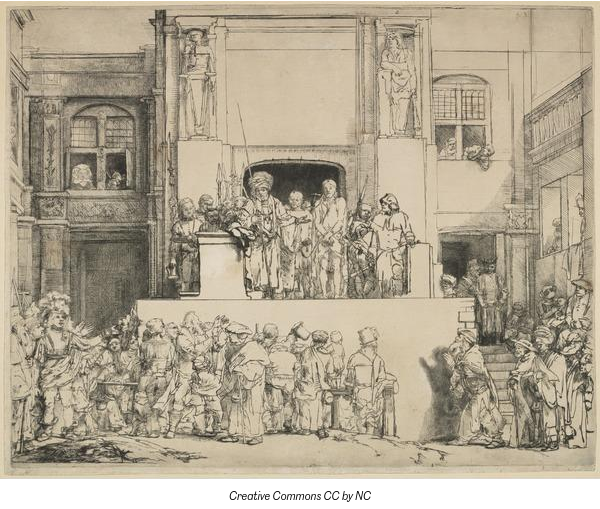
Above: Christ Presented to the People ('Ecce Homo'), Rembrandt, 1655, Drypoint.
An unfamiliar name to me, Joan Hassall produced a print called The Stricken Oak that is absolutely amazing.
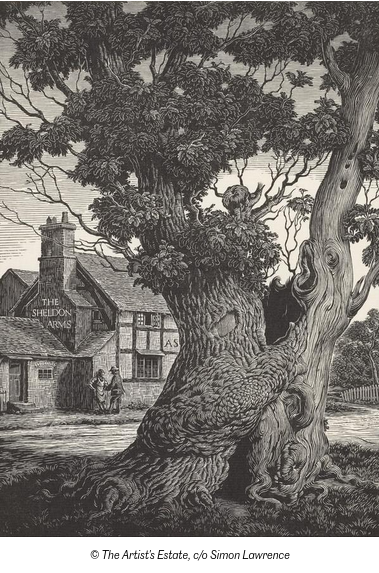
Shown on the right, it should be seen in all its glory, either in real life or the National Gallery of Scotland web site. A beautiful and very finely detailed wood cut.
Right: The Stricken Oak, Joan Hassall. Wood engraving on paper, 1937 [link].
There are a lot of pieces worth seeing and this only scratches the surface. We also have William Blake: tiny wood engravings illustrating Thornton's Pastorals of Virgil (see the Tate site).
Hokusai, Otto Dix, Toulouse-Lautrec, Degas, Picasso, Goya, Constable and more.
I'm a member of the National Gallery of Scotland so it is an easy decision to go back for another look. However, even if I wasn't a member, I think another visit would be hard to resist.
Printing has been something I have wanted to try my hand at for a long time and this is another little push to have a go sometime.
I rarely think about using a spell-checking program: I've always thought I was fine reading what I wrote and fixing any mistakes myself. I can spell. But the other day, reading back a short blog post (again) I noticed a couple of errors I should have seen earlier. I could easily have "published" them. This made me think about a vim spell-checker.
It turns out there is a very easy way to do a spell-check in vim:
:set spell

This highlights words considered misspelled. There are keys to jump between them and
also to pop open a list of suggestions (see: :h spell).
A very useful tool on occasion. I must remember to use it before pushing anything out to the world!
There are lots of different things going on in December: markets, fairs, shows, exhibitions, concerts. Too much to see everything so you have to be a bit picky. Unfortunately, a lot does tend to clash at weekends.
A case in point last weekend were so many artist studio spaces having an "open studios" at the same time: Coburg House, Patriothall and Out of the Blue Abbeymount. I wanted to see Abbeymount Studios (I've never been) but prioritised Patriothall because it is near me and I was a bit time constrained. All this was on top of Out of the Blue Arts Market, Summerhall Christmas Market and quite a few other markets. All go!
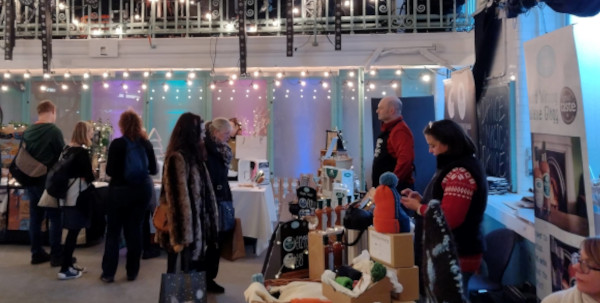
I went to Summerhall Christmas Market on Saturday afternoon and thoroughly enjoyed wandering around the stalls in all the various rooms of the rambling old building. Until 2011 it was "The Royal (Dick) School of Veterinary Studies" but now it's a big arts venue with a lot of very diverse programming.
The best thing about well curated markets like Summerhall is the quality of the stallholders: creators and makers. Much to see and many are worth drawing attention to but I'm always particularly interested in any visual artists around.
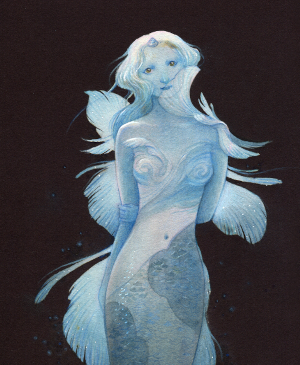
Marie-Alice Harel
One of the creators present was Marie-Alice Harel, an artist and illustrator.
I recognised her work from a book I'd seen at Transreal Fiction, a self-published art book called Bird People.
As she says on the web page, it certainly is "curious": "a reflexion on nature and culture, on the blurry line between human and animal". Her art is fine, detailed and beautiful to look at, in the classic tradition of Edmund Dulac. She's won some awards and exhibited quite widely. There's lots on her web site, including some process. More to come I expect!
Left: A detail from Into the Deep, Watercolor and ink, 2020. © MÄ HAREL [link]
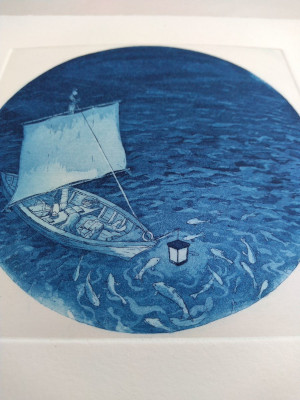
Joanna Robson
Another artist and illustrator with a table exhibiting her work was Joanna Robson.
Robson's also an accomplished artist with an attractive body of work. I was particularly struck by the prints she had on display.
The etching Haven has a blog post describing the background and technique. Having recently visited the Scottish National Gallery's The Printmaker's Art, it's great to see the actual copper plate the etching is inscribed on. It looks beautiful.
Right: Haven, etching. © Joanna Robson [link]
Overall, an excellent Christmas market at Summerhall, made so good by the people taking part. I will definitely want to go next year as well. I also bought some Kimchi from Edinburgh Fermentarium. I've now finished the pot of "Mac Kimchi" : "A kimchi for those of us who crave the deep spicy umami of traditional Korean kimchi". Recommended.
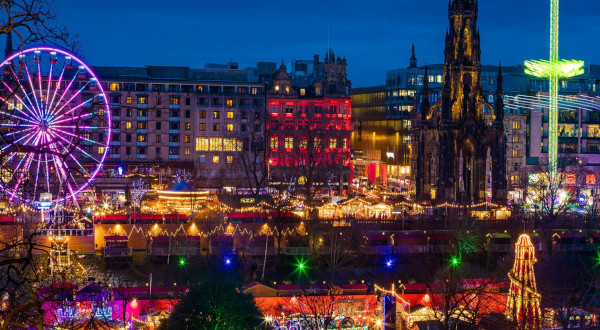
Well, tis the season to go shopping it seems.
Edinburgh is jam packed with people in the town center. I read that the official Christmas Market on Princes Street is unbearably busy, with some people turning around and walking away because of the queues. Even outside the main areas things are busy, especially at weekends. Luckily, I'm an early bird so, if I need to go near the epicentre, I can mostly avoid the crush. I assume it will be getting worse.
It's definitely something to take in at night though. I like this time of year because of the number of things to do but I prefer the smaller and less commercial attractions. Some reports to come hopefully.
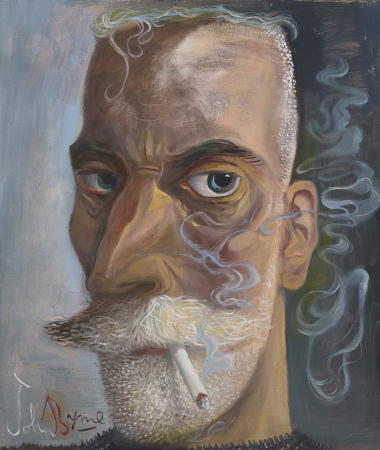
Above: Biggish Self Portrait, John Byrne. Oil on Board. 61x71cm
John Byrne, one of the best artists Scotland's produced, died today. He was a natural : he had to draw (write,paint) to live.
I was mostly familiar with his painting, drawing and print making and he was very prolific. In addition to this, he was a successful writer and playwright.
Definitely a big Byrne-shaped hole in the Scottish arts scene.
I saw a lot of his work over the years in Edinburgh, and would even occasionally see the man himself around town (or in the Art Shop). A very dapper dresser. He was fond of doing self-portraits, often with a cigarette in his mouth: not very good for his health although he lived to a good age (like another famous artist smoker, David Hockney).
Although I'll miss seeing new art works from him, I look forward to a proper retrospective exhibition.
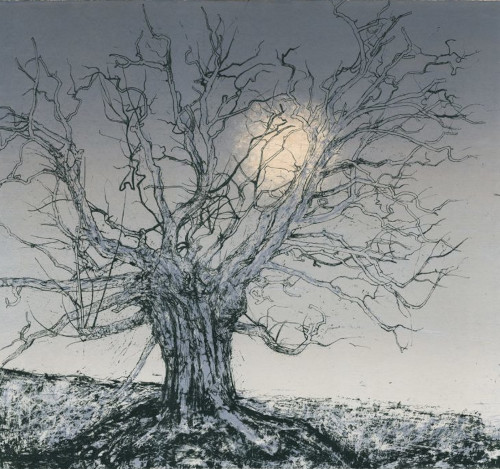
There is a bit of winter sun around just now in Edinburgh: an occasional bright sun, weakly warming, with clouds and the threat of rain, sleet or snow. Perhaps all three on the same afternoon. It's very cold but this is something you need to get used to during a winter in Scotland. There's often no sun at all and it can be quite dark and dismal all day.
The Scottish Gallery's December exhibition is called Low Winter Sun and celebrates the sort of weather we might get up here at this time of year. Victoria Crowe is the artist and always a welcome sight in the gallery; an artist I like and have admired on this blog.
Some of Crowe's work in the exhibition are monotype prints, and they're good. From Jackson's Art blog :
The blog linked above also describes how to make a monotype print. Even better, Victoria Crowe shows how it is done on the Scottish Gallery's YouTube channel : The Making of Burnished by a Late Sun (YouTube video).
The exhibition is on for a few weeks and I'll visit again.
If you use DHCP anywhere, you know that the server sends network configuration to you, the client, to set up things like your IP address, gateway, DNS server etc. An essential service today for most devices. What if you change something in the server and need to refresh these settings?
On Linux when using the NetworkManager program to deal with networking, you can easily release and refresh the configured settings using the NM command line tool nmcli. See what network conections are present :
nmcli connection show
Identify the network you want to refresh ("NAME") and switch it off ("down") :
nmcli connection down id "NAME"Replace "NAME" with the name of the conection (you will need quotes if there are any spaces in the name of the connection).
Turn it back on ("up") :
nmcli connection up id "NAME"
This should refresh your network configuration to reflect the server change you have made.
References:
Putting my "What I learned Today" efforts in the shade is Josh Branchaud's "Today I Learned" (TIL) repository of useful knowledge. He's been adding to this for quite a few years and it's a very impressive collection. It's on Github.
The banner at the top of my blog at the moment (end of October 2023) is a detail from a photograph I took a couple of years ago on Bruntsfield Links, Edinburgh. The banner (cropped a little) :

This was a lovely sunny afternoon in September 2020. I used the photograph as a reference for a painting I completed late last year (November 2022). The painting came out fairly well I think. I've come to terms with how much green there is. I think. The painting :
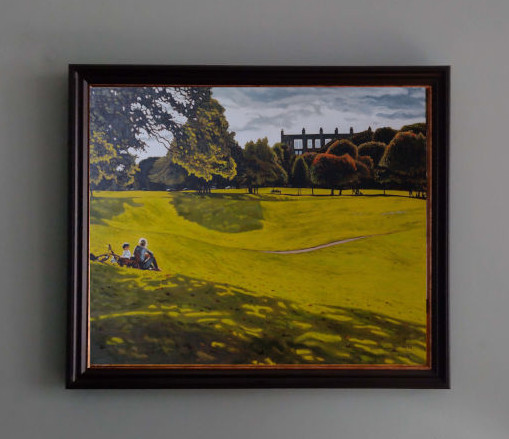
Above: Sunny Afternoon at the Links, oil on canvas, 60x76cm
A detail from the painting :

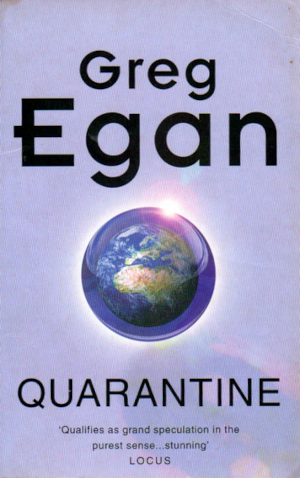
Quarantine
By Greg Egan
Score: 4/5
A near future Earth, cut off from the rest of the universe by a "bubble" in space blocking out the stars and any access to the universe beyond the solar system. A future Earth where brain modifications ("mods") are easily bought and installed, giving the user ways of taking a call in their sleep, suppressing boredom or even bringing a visible and audible avatar of a dead partner to life. Maybe an idea installed: something that becomes a central part of who you are. However, this is the least of it in Greg Egan's novel. It gets even stranger: quantum physics strange. What is the quantum wave function and what does it mean when it "collapses"?
If you know what Schrödinger's Cat is, or a bit about Quantum Physics (the strange and sometimes outlandish theory of the subatomic world) you might think you have an understanding of what's in store: you might need to think again.
I enjoyed reading this but must admit that the speculation was tough going on some occasions (also: I have a Physics Degree). Quantum Physics is a very successfully theory of the world but also notoriously difficult to understand on many levels (beyond the mathematical equations). This is definitely not your average "speculative" fiction book, science-fiction or otherwise and Egan has form; he is not afraid to consider the stranger aspects of science and where it leads. It can be mind-bending stuff, so great fun sometimes but also hard to follow on occasion.
This is definitely not a book everyone will like; probably a book only a few will manage to get through perhaps. But for those that like their science-fiction to have harder "science" in it, you can't beat Greg Egan's novels and I would highly recommend you have a look at Quarantine. Especially if you are interested in the ramifications of Quantum Physics.
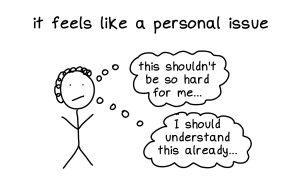
Above: Slide 4 © Julia Evans
Almost a followup to the recent post about removing complexity and keeping things simple: a recent post by Julia Evans (a software developer in Canada). She has a video and a transcript of a talk she gave entitled Making Hard Things Easy and makes a case that far too much knowledge is poorly documented and hard to understand. She's primarily talking about technical things, like the Bash Shell or DNS, but the main point is applicable to many other things in normal day to day life and work. This is why we write an "executive summary" on a report. We want to extract the important parts of a (possibly long and involved) document and present them in an easily digested list up front. Fundamentally, it is all about good communication.
"Keep It Simple, Stupid" is often an apt plan in life, not just in your technical endeavours. If something is complicated, it's easier to build badly, or break.. So I will place this "What I Learned Lately" post in the "general" section.
I was looking at the state of the technical back-end of my web site and blog (such as it is), trying to recall how it all fit together: what this or that file (or style) did and where it came from. Most of it is quite simple: the blogging "platform" itself is straightforward (a small CGI script called blosxom), the rest generally static. But I had included some bigger components, a so-called "framework" (Foundation), of which I was only using a tiny portion (barely noticeable really). Also extra fonts, mostly unused but cluttering up the HTML. When you add complexity like this, things can get slower and harder to extend. The final problem was: I barely understood what this extra stuff was or how it worked.
So, I stripped it all out and put back just enough of my own work to keep the site and blog looking decent (mostly the "same" hopefully). This is now small and easily managed, and also something I fully understand. If I want to work on building my knowledge of HTML, CSS and Javascript (something I want to do), then it's best to start simple.
A final thing to note: testing the site to make sure it still worked and looked okay, I came across a lot of my old blog posts. Book reviews, some social comment, galleries and art. It all builds up and is fascinating to read now (to me at least). It's amazing to look back and recall I actually owned a Firefox Smartphone! Unfortunately it didn't work out for the long term. Things are a lot better now of course /s
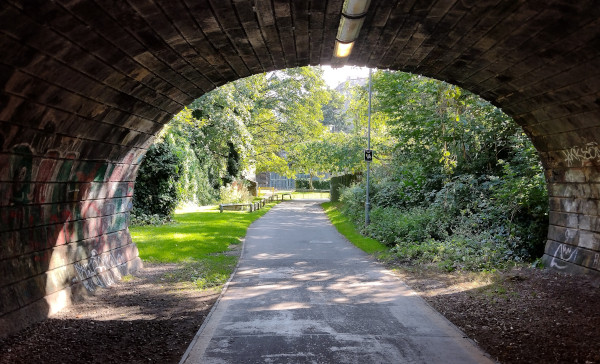
Above: Into the sunlight through Rodney Street tunnel, Canonmills, Edinburgh 2023.
It's finally open. It's been a long and frustrating wait in many ways, but Scotland's new National Gallery of Art opened its doors to the public for the first time last Saturday. Many delays, some due to the pandemic, and a lot of money spent. But we have something to visit at last and the bottom of the Mound is beginning to look somewhat presentable again (although I have a bit of a complaint: see below).

The new gallery is laid out along the length of the main gallery building, but underneath it. In the photo above, the new extension is all the way at the back, stretching away under the National Gallery building at the far end. Unlike the old spaces for the Scottish collection, the new area doesn't feel so much like a basement now. It's lighter and better laid out.
I like the new gallery and I am very happy that it is finally open. Like many, it was dragging on a bit but you can't argue with the great art work we can finally see again. It makes a big difference to see the paintings in a well lit and more open space. And even though it is hard to integrate with the rest of the gallery space, it's a huge improvement.

Above: St Bride (detail/full), John Duncan, Tempera, oil and gold leaf on canvas, 122.30x144.50cm
The gallery site has a fuller section on Celebrating Scotland's Art.
You can also have a look at a YouTube video which walks you through the space.
I wish they actually cleaned up the mess and litter outside the gallery in real life, rather than just virtually. Council or gallery problem ownership? Also, hooray that the Playfair Steps are also open again.
Every year, the Mall Galleries in London hosts an exhibition of the Royal Society of Marine Artists and the 2023 show finishes on September 30th. Unfortunately, I don't get down to see them anymore, but the gallery always puts them online and it's the next best thing. As always, amazing works of art.
Some awards are given out each year (online). Frankly, they're all excellent but here are two I particularly like. Jenny Aitken's Sundown from Harwich Quay (link) because of the beautiful evening light, and Raymond Leech's Evening Crabbing Session Blakeney (link) because of it's lovely "painterly" execution. Great light as well!
 Above: Sundown from Harwich Quay, Jenny Aitken, Oil on canvas, 40x50 cm
Above: Sundown from Harwich Quay, Jenny Aitken, Oil on canvas, 40x50 cm
 Above: Evening Crabbing Session Blakeney, Raymond Leech, Oil on canvas, 18x23 cm
Above: Evening Crabbing Session Blakeney, Raymond Leech, Oil on canvas, 18x23 cm
The world is a lot better with good art.
There is a more straightforward way to do this, plus a more arcane way (syntax-wise). There's a lot of arcane in the Bash Shell and in some ways, it's like Vim: you just have to get used to things, try and remember them and not ask "why?" too much.
If you have a file path and want to know the last part (usually the file name) only, you
can use the command basename (man basename) e.g.
If I have a path : /usr/include/stdio.h, then :
basename /usr/include/stdio.h
Gives me : stdio.h.
The command also has options to strip a suffix (e.g. the ".h" part).
Alternatively, a more arcane was is to use the parameter expansion functionality of the Bash shell.
FILENAME="/usr/include/stdio.h"
echo "${FILENAME##*/}"
This is looking for a pattern ("##") and stripping everything up to the last "/" (*/).
This also gives : stdio.h
Did I mention arcane? There are are lot of very useful features like this in the Bash shell but they can just be a little hard to remember sometimes (and you have to watch out for "gotchas" using them!).
Reference:
See Bash Manual : Parameter Expansion
In vim you can be in a visual selection mode, perhaps selecting only parts of the text file. Normally, a substitution operation (e.g. replace string "2022" with "2023") operates on a whole line (or range of lines). To restrict this to operate only on the visual selection you have, use the "\%V" pattern at the start of your search.
So, assuming a visual selection is highlighted and within this I want to change "-" to " " :
:'<,'>s/\%V\-/ /g
A highlight containing "This-is-a-test" becomes "This is a test".
See Vim help %V
Reference :

My server has USB 2.0 only and I thought I'd upgrade it to USB 3.0 via a Startech USB 3.0 PCI card. Installation was straightforward but after restarting the computer I discovered my networking was broken.
It turns out that my ethernet device used to be enp2s0 but was now enp3s0 and my network setup failed.
This type of kernel device name is created based on various schemes e.g. the physical location of the connector of the hardware on the PCI bus. See the Redhat Docs.
I've been using Linux for many years now and computers have changed a lot in this time. Leaving aside the huge advances in CPU, RAM and storage, many computer devices are not "fixed" in place but can come and go (even CPU's and RAM). Mostly, these devices might get plugged in or out, such as a USB mouse or external USB hard drive. PCI devices are also capable of being "hotplugged" and when any of this happens, the kernel has to scan the new configuration and determine what devices are present. Sometimes it has to re-arrange the device names.
My server is an old HP Microserver (N36L) : 12 years old now but still going strong (although it needed a new power supply last year). Because I use an external USB disk for backup, USB 3.0 will speed things up a lot (I hope). On to the reboot and networking failure ...
To fix this, I could just change my ethernet device name in my network setup files (i.e. /etc/network/interfaces on Debian). I decided to use systemd and create my own persistent and simple (old-fashioned) name for the device.
Systemd Link
This is "link" as in a network link (man page : systemd.link).
Use :
ip l
to get the MAC address for the network device enp3s0. Then create the file :
/etc/systemd/network/10-eth0.link
The file must end with ".link" and preferably begin with numbers (as a run order). It contains :
[Match] MACAddress=<YOUR MAC ADDRESS> [Link] Name=eth0
I edited my network setup scripts (Debian : /etc/network/interfaces) to use the network name "eth0". Now, when I boot the system, the name "eth0" is set on the network device with my main ethernet MAC address and will stay that way.
I must add that I like systemd and how it's changed the Linux boot and system control landscape.
In January last year, I posted a piece about a small study I had done of Arthur's Seat called The Seat by the Loch. I worried that the picture was a bit too saccharine. Maybe it was, but I decided I ignore any qualms and go all in on the "colour" : and so painted a larger version. This was done in July 2022 and I think it turned out okay. So, varnished, framed and hanging on a wall somewhere near me :

Above: View of St Anthony's Chapel and St Margaret's Loch, Oil on Linen, 60x80cm
This is a view of St Margaret's Loch and St Anthony's Chapel on Arthur's Seat, Edinburgh. I'd sometimes have lunch sitting up there with friends, and sharing the rocks opposite the chapel with some ravens chasing any crumbs falling their way. Better a raven than a gull.

What I learnt Lately no. 2 : How to change the colour Vim uses for its tabs.
The editor Vim has "tabs" similar to tabs in other applications (text editors, browsers), or at least can be made similar. I use a plugin called buftabline for my Vim tabs. Vim buffers are shown as classic-style tabs along the top of the window.
One thing I didn't like was the fact that the empty space on this tab bar was shown as white :

To change this, use the "highlight" command and apply different colours to the tab elements :

That's much better and a lot clearer to see what buffer/tab I'm looking at with a glance.
This is what I have in my .vimrc settings file :
highlight TabLineFill term=bold cterm=bold ctermbg=0 highlight TabLineSel ctermfg=0 ctermbg=LightYellow
Note that the vim plugin buftabline has its own set of colour (highlight) groups e.g. BufTabLineActive (these are linked to the built-in tab groups). See the github page.
Reference :
This page was very useful :
I love tinkering around with the computer and digging into some of the aspects of running Linux, or the more interesting applications it can host. Take the editor Vim. Not a text editor for the masses (to say the least) but it does have an extremely broad and deep set of features and also a whole swathe of settings for them. I've not done much painting recently and have spent some time sorting out my computing experience. For this, I've learnt quite a few new things and it's made me remember how pleasurable learning stuff is.
So : What I have learnt lately a.k.a. WILL. Maybe I will try and document some of these things, if only for my own reference later.
Vim Lookaround
Viewing some old server backup logs (something else I've been "fixing"), I wanted to jump to the next line not starting with a word ("deleting").
I use the Vim text editor and to find a line that starts with a string, use the "^" regex anchor. Press "/" and :
/\v^deleting<cr>
The "<cr>" means press the return/enter key. So "^deleting" matches the word deleting at the start of a line.
The "/v" means interpret the pattern used as "very magic", so no need to quote brackets etc. See vimdoc for an explanation.
Now for the good stuff (and new to me) : to find a line not starting with "deleting", press "/" and :
/\v^(deleting)@!<cr>
This is similar to before but we wrap the pattern in brackets and end with "@!". The "@!" is a negative lookaround (i.e. "lookbehind") i.e. looks for no matching pattern behind us. The "^" means "at start of line" (behind us).
To help retain a piece of knowledge, it's usually useful to write it down somewhere.
Reference :

The Book of the New Sun
by Gene Wolf
Score: 2/5
The Book of the New Sun by Gene Wolf is composed of four "books" that I have in two volumes. It is set on a far future Earth, with the sun dying but human kind still around. Much has changed and much forgotten, almost all history is lost or barely remembered.
In brief, we follow a young man called Severian, an apprentice torturer (the guild otherwise known as "The Seekers for Truth and Penitence"). Expelled from his guild for showing mercy, he is exiled and has to go on a journey to a far city, armed with an impressive sword and picking up a mysterious gem stone by accident on the way. We meet some odd characters who he joins or join him, and he battles some more bizarre creatures. The gem stone has some strange power and over the course of his travels he learns part of the secret to the world and its governing powers.
A number of times over the last few years I have come across people saying how great this novel was and so I added it to my reading list. The time was finally right to jump in. Or so I thought.
Well, I seriously struggled to get through the books and almost gave up on multiple occasions: after the first book, then after the second. I think I decided that, like having a "sunk cost" here, I might as well push through it. It's not a bad book, and not badly written, but just quite baffling in many ways. I found the (far future Earth) world interesting but hardly revealed or explained. The same with the characters, whose motivations were obscure to me mostly. Always expecting the pace to pick up and something to happen, it mostly didn't and things plodded forward, often slowly. When things did happen, they often seemed to happen as merely a plot device: people would appear, go away and then meet later. Often a bit too much coincidence. As each book ended, I felt generally unrewarded. On to the next?
Like I say, I did read all of them and the books improved for me after the bumpy start. Maybe it was actually the wrong time for me to read the novels; maybe I was expecting something quite different. When I read many other positive reviews now I see much talk of the books needing to be read more than once, to get the nuance and pick up Wolf's cleverly constructed, but slightly obscured, meaning. However, I think a book should stand up to a first reading. Even if the novels contain a lot of not-so-obvious clues to the events and history of the place, Wolf might have been a bit too clever for me.

Leviathan Falls
by James S. A. Corey
Score: 5/5
As written on the frontispiece of the last in the series :
Nine books later and you're still here, so this one's for you.
Nine books is very impressive. They're chunky as well, but the biggest deal is how consistently good they are. And nine books later I get to the end of The Expanse and close the final book, Leviathan Falls. I've waited a long time for the last book to appear: the paperback version seemed to take forever to get released.
This has been the best action/adventure series I have read, consistently good and usually great. The series started well and stayed that way: if anything, it got better. Quite a believable future mapped out by the two authors, Daniel Abraham and Ty Franck ("Corey" is a pen name), with the solar system politics and fighting looking a bit parochial as the story expanded into a huge galaxy spanning collection of worlds.
In the end though, what made these novels special were the characters, who we get to know, understand and love. With the vast distances involved, the characters age and by the final few books, they're decades older, and showing it. We've grown besides them.
It's always hard finishing a book you love reading and even if the end is somewhat bitter-sweet, Leviathan Falls does not disappoint.

Player of Games
by Iain M. Banks
Score: 4/5
Second time lucky? The last time I read Player of Games I was underwhelmed. I thought the book was okay but a little dull, perhaps a bit hard to understand and lacking in action. Over the years since, however, I keep on coming across people online who consider this book a favourite, and perhaps the best "Culture" novel he wrote. So, an impetus to give it another chance. As is increasingly clear to me, the reaction you have to a book is very dependent on when you read it.
So now I am very glad I came back to the novel because I really liked it this time. I'd forgotten almost all of the story so it felt fresh. It is not action packed, akthough it has some and is a bit more "cerebral" perhaps. The story's about a complicated game: a "game" a society uses as a part of its organising principles. So we learn about cruelty, hierarchy, equality and politics through a cast of very different, and not always very likeable, characters. This is typical Banks, as is the "Culture" culture and humour, including a malicious drone. Things are not always what they seem but we get a satisfying, dare I say, happy ending?
I think I would now consider myself a "booster" of this book.

Going through some of my old comics and comic books, I came across a hardback French edition of Moebius' Le Garage Hermétique, the first version in colour. A true classic of French bande dessiné and a strip I first came across in the American Heavy Metal magazine in the late 1970's. This colour version was published by Les Humanoïdes Associés in October 1988.
Inside is a colour poster insert: a blow-up of one of the most striking panels in the strip. I had completely forgotten about his but what a wonderful surprise to rediscover. It is revealed that it was a woman under that hat all along, not a man!
This is not something to leave hidden away inside a book anymore. It deserves a frame and to be hanging on a wall. RIP Jean Giraud a.k.a. Moebius.



